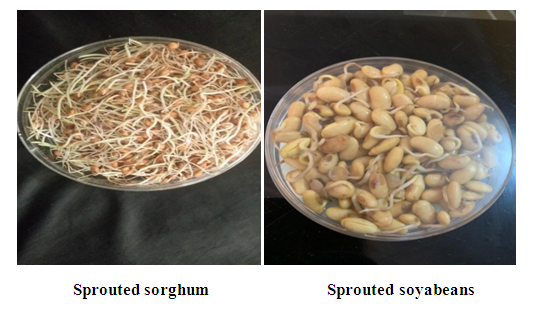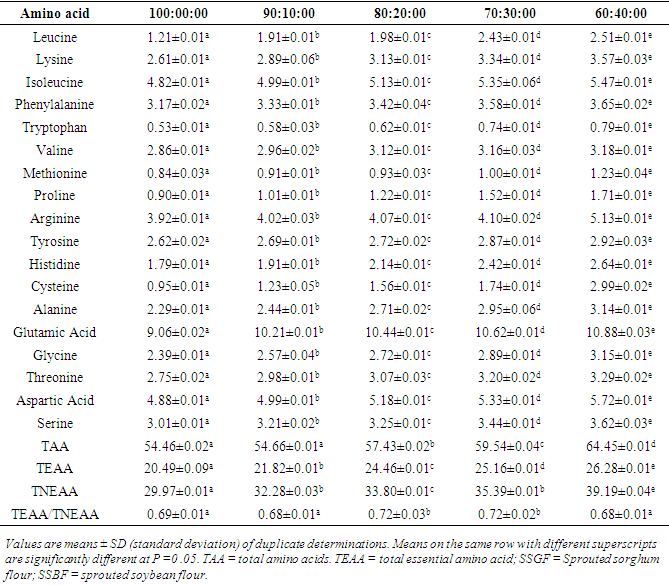-
Paper Information
- Paper Submission
-
Journal Information
- About This Journal
- Editorial Board
- Current Issue
- Archive
- Author Guidelines
- Contact Us
International Journal of Food Science and Nutrition Engineering
p-ISSN: 2166-5168 e-ISSN: 2166-5192
2022; 12(1): 20-25
doi:10.5923/j.food.20221201.02
Received: Jun. 7, 2022; Accepted: Jun. 27, 2022; Published: Jul. 15, 2022

The Potential of Sprouted Sorghum Supplemented with Sprouted Soybeans in the Formulation of Preventive Diet for Osteoporosis
Enemali Ojochenemi JohnPaul, Omede Ameh, Eneh William Nebechukwu, Ibrahim Iye Asenetu, Ovabor Bright, Suleiman Ibrahim Zainab, Hussaini Jonathan Solomon, Igwe Chinwe Vivian, Ishaya Daniel Bwala, Rita Ifeyinwa Hanson-Akpan
National Space Research and Development Agency (NASRDA), Obasanjo Space centre, Umaru Musa Yaradua Expressway, Lugbe, Abuja, Nigeria
Correspondence to: Enemali Ojochenemi JohnPaul, National Space Research and Development Agency (NASRDA), Obasanjo Space centre, Umaru Musa Yaradua Expressway, Lugbe, Abuja, Nigeria.
| Email: |  |
Copyright © 2022 The Author(s). Published by Scientific & Academic Publishing.
This work is licensed under the Creative Commons Attribution International License (CC BY).
http://creativecommons.org/licenses/by/4.0/

Osteoporosis is a disease of the bone caused majorly by vitamin D deficiency, low calcium, bad eating habits, lack of oestrogen etc. Fortified diets had been used in the treatment of clinical disorders such as this. This study investigated the effect of sprouting on formulation of preventive diets for osteoporosis from sorghum and soyabeans flour blends. The sorghum and soyabeans were sprouted separately for five days. Sprouts with maximum nutrient were obtained and milled into flours. Sorghum flour was supplemented with 0, 10, 20, 30 and 40% soyabeans respectively. Proximate analysis of the samples showed that supplementation increased the crude protein, fat, ash, crude fibre and moisture contents of the blends significantly (p<0.05) from (10.98±0.01a -23.01±0.01e %), (3.28±0.01a - 10.02±0.04e %), (8.78±0.01a - 10.82±0.01e %), (1.06±0.02a - 4.01±0.01e %), (10.99±0.02a -12.72±0.01e %) respectively while carbohydrate decreased significantly (p<0.05) from (64.04±0.02e - 39.21±0.01a %). Supplementation of 10% and 40% increased total amino acid (TAA) significantly (p<0.05) from (54.46±0.02a - 64.45±0.01d g/100g), total essential amino acid (TEAA) increased significantly (p<0.05) from (20.49±0.09a - 26.28±0.01e g/100g) same trend was observed for total non-essential amino acid (TNEAA) as it increased significantly (p<0.05) from (29.97±0.01a -39.19±0.04e) tryptophan was the limiting essential amino acid (0.79±0.01e) while glutamic acid was the most abundant amino acid with the value (10.88±0.03e). Generally, soya beans improved sorghum quality and food formulated from the blends may serve as a potential diet for the prevention of osteoporosis.
Keywords: Osteoporosis, Phytoestrogen, Sorghum, Soyabeans, Sprouting, Vitamin D, Calcium
Cite this paper: Enemali Ojochenemi JohnPaul, Omede Ameh, Eneh William Nebechukwu, Ibrahim Iye Asenetu, Ovabor Bright, Suleiman Ibrahim Zainab, Hussaini Jonathan Solomon, Igwe Chinwe Vivian, Ishaya Daniel Bwala, Rita Ifeyinwa Hanson-Akpan, The Potential of Sprouted Sorghum Supplemented with Sprouted Soybeans in the Formulation of Preventive Diet for Osteoporosis, International Journal of Food Science and Nutrition Engineering, Vol. 12 No. 1, 2022, pp. 20-25. doi: 10.5923/j.food.20221201.02.
Article Outline
1. Introduction
- Osteoporosis is a bone disease characterized by low bone mass and low bone mineral density (BMD), which leads to a high frequency of bone fragility and fractures [1]. The mass of skeletal bone is influenced by a number of factors majorly extrinsic (nutrition, exercise) and endogenous (genes, metabolic hormones) factors [2]. several therapeutic treatments have been designed to prevent or treat bone loss in patients suffering from osteopenia. Adequate nutrition has also been alluded as a key treatment for osteoporosis as nutrition plays an important role in bone health, and there is an increasing interest in dietary nutrients which influence bone metabolism and health such as Ca and VD [3]. Reduced dietary intake of Ca is associated with reduced bone mass and leads to osteoporosis. Chronic VD deficiency leads to osteomalacia [4]. Therefore, maintaining adequate diet and intake of calcium and vitamin D is important in maintaining bone mass density as Vitamin D enhances intestinal absorption of calcium and phosphate. Calcium is an essential nutrient that is necessary for many functions in human health. Calcium is the most abundant mineral in the body with 99% found in teeth and bone. Research has also shown that adequate calcium intake can reduce the risk of fractures, osteoporosis, and diabetes in some populations [5].However, Low concentrations of vitamin D are associated with impaired calcium absorption, a negative calcium balance, and a compensatory rise in parathyroid hormone (PTH), which results in excessive bone resorption [6]. Prevention of vitamin D deficiency (VDD) which in turn leads to calcium imbalance remains a health priority globally [7]. Food fortification and supplementation with Vit D is considered one of the most cost-effective strategies to combat and address VDD. Supplementation with Vit D is also effective to address VDD [7], but this requires close control of the dose due to potential toxicity, resulting in hypercalcemia and hypercalciuria [8]. Studies have equally shown that oestrogen has a protective role against osteoporosis. Soybeans have been linked to many health benefits and its rich in protein and many vitamins and minerals. It is also rich in phytoestrogens known as isoflavones. Phytoestrogens are isoflavones, which are plant-derived phenolic chemicals with estrogenic action. Soybeans and soy products are high in protein and are the richest sources of phytoestrogen compounds in human diet. In addition, soy isoflavones can produce estrogen-like activity in the body by mimicking the effects of natural estrogen [9]. Sorghum is one of the indigenous staples used in addition to other food sources in diet formulation. it is known to be rich in phenolic compounds with appreciable anti-oxidant properties. The starch from sorghum is also good in weight control, hence perfect staple for astronauts intending space mission.Sprouting is a physical modification method used to enhance the quality of food. It is the process by which seeds or spores are induced to germinate or put out shoots mainly for the purpose of consumption or commercialization. Earlier studies have shown that sprouted foods play protective role in the body [10].One of the major obstacles to long-term space missions is the threat of severe bone loss in astronauts. In the microgravity environment of space, astronauts lose on average 1% to 2% of their bone mineral density every month. For a short-duration flight. On a long-duration space flight, such as those planned for missions to Mars and beyond, bone loss can be a serious impediment. This loss may not hinder astronauts while they are in orbit, but upon return to Earth, their weakened bones will be fragile and at an increased risk of fractures [11].
2. Materials and Methods
2.1. Sample Collection and Preparation
- Sample collectionSorghum and Soya bean seeds were purchased from Lokoja international market Lokoja, Kogi State of Nigeria. Sample PreparationThe seeds were hand picked to remove extraneous materials. Sorghum and soyabeans were soaked separately in water for 6 and 8 hrs to enable the seeds sprout. After soaking, the seeds were sprouted in trays covered with aluminium foils and water was sprinkled on the seeds at intervals to keep seeds wet, thereby providing an enabling environment to achieve sprouts [12]. Maximum sprouts were achieved for sorghum on day 3 while soyabeans attained full sprout on day 4 respectively. Samples were dried and milled into a fine powder using an electric mill.
2.2. Reagents and Chemicals
- All chemicals and reagents used were of analytical grade produced by British Drug House (BDH) Limited, England and Sigma Aldrich Chemical Company Incorporation, Milwaukee, Wisconson. USA.
2.3. Proximate Analysis
- Proximate nutrient determination Moisture, ash, crude protein, crude fat and crude fibre were determined by standard methods [13]. Total percentage carbohydrate was determined by the difference method [14]. The method involved addition of the total values of the different parameters (crude protein, crude fat, crude fibre, moisture and ash) elements of the sample and subtracting it from 100. The value obtained was the percentage carbohydrate constituent of the sample [15].
2.4. Amino Acid Analysis
- The sorghum and soyabeans' amino acid profile was analyzed using the Technicon sequential MultiSample Amino Acid Analyzer (TSM) according to the method described by [16].
2.5. Dietary Formulation
- Five experimental diets were formulated using the method described by [17].
2.6. Data Analysis
- Statistical Package for Social Sciences (SPSS) version 21 was used to conduct a statistical analysis on the triplicate value of the data obtained. Using the Duncan Multiple Range Test (DMRT) with a confidence level of p 0.05, analysis of variance (ANOVA) was employed to determine the degree of significance.
3. Results and Discussion
- Results
 | Plate 1. photograph of sprouted sorghum and soyabeans |
|
|
4. Conclusions
- In this study, it was found that supplementation of sorghum with soyabeans protein enhanced the general quality of the formulated diets with increase in soyabeans content. furthermore, the blend was found to contain the nine essential amino acids. This suggests that the formulated diet was a standard diet and be serve as a potential diet in the prevention of osteoporosis.
5. Recommendations
- It is recommended that further investigations are needed on formulated diets from sorghum and soyabeans such as phytoestrogen, antinutrients, vitamins etc in furtherance of the viability of the diets. In the same vein, other staples such as rice, millets, beans etc can be investigated. Also, the use of animal model to check toxicity, biochemical parameters, haematological indices etc are required.
ACKNOWLEDGEMENTS
- The authors would like to appreciate the Laboratory Technologist at the Baze university Abuja and Federal University Lokoja for their technical support in the course of this work. Thank you most profusely.
 Abstract
Abstract Reference
Reference Full-Text PDF
Full-Text PDF Full-text HTML
Full-text HTML
